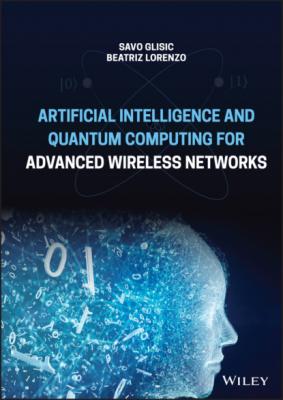Artificial Intelligence and Quantum Computing for Advanced Wireless Networks. Savo G. Glisic
Чтение книги онлайн.
Читать онлайн книгу Artificial Intelligence and Quantum Computing for Advanced Wireless Networks - Savo G. Glisic страница 94
 narrow frequency bands. The spectral graph convolution of CayleyNet is defined as
narrow frequency bands. The spectral graph convolution of CayleyNet is defined as
(5.41)
where Re(·) returns the real part of a complex number, c0 is a real coefficent, cj is a complex coefficent, i is the imaginary number, and h is a parameter that controls the spectrum of a Cayley filter. While preserving spatial locality, CayleyNet shows that ChebNet can be considered as a special case of CayleyNet.
GCN [14] introduces a first‐order approximation of ChebNet. Assuming K = 1 and λmax = 2, Eq. (5.40) is simplified as
(5.42)
To restrict the number of parameters and avoid overfitting, GCN further assume θ = θ0 = − θ1 , leading to the following definition of a graph convolution:
To allow multi‐channels of inputs and outputs, GCN modifies Eq. (5.43) into a compositional layer, defined as
where
(5.45)
Several recent works made incremental improvements over GCN [14] by exploring alternative symmetric matrices.
Adaptive Graph Convolutional Network (AGCN) [16] learns hidden structural relations unspecified by the graph adjacency matrix. It constructs a so‐called residual graph adjacency matrix through a learnable distance function that takes two nodes’ features as inputs.
DGCN [17] introduces a dual graph convolutional architecture with two graph convolutional layers in parallel. While these two layers share parameters, they use the normalized adjacency matrix
(5.46)
where v1, v2 ∈V, ∣D∣
Spatial‐based ConvGNNs: Analogous to the convolutional operation of a conventional CNN on an image, spatial‐based methods define graph convolutions based on a node’s spatial relations. Images can be considered as a special form of graph with each pixel representing a node. Each pixel is directly connected to its nearby pixels, as illustrated in Figure 5.3a (adopted from [38]). A filter is applied to a 3 × 3 patch by taking the weighted average of pixel values of the central node and its neighbors across each channel. Similarly, the spatial‐based graph convolutions convolve the central node’s representation with its neighbors’ representations to derive the updated representation for the central node, as illustrated in Figure 5.3b. From another perspective, spatial‐based ConvGNNs share the same idea of information propagation/message passing with RecGNNs. The spatial graph convolutional operation essentially propagates node information along edges.
Neural Network for Graphs (NN4G) [48]: Proposed in parallel with GNN*, this is the first work toward spatial‐based ConvGNNs. Distinctively different from RecGNNs, NN4G learns graph mutual dependency through a compositional neural architecture with independent parameters at each layer. The neighborhood of a node can be extended through incremental construction of the architecture. NN4G performs graph convolutions by summing up a node’s neighborhood information directly. It also applies residual connections and skips connections to memorize information over each layer. As a result, NN4G derives its next layer node states by
(5.47)
where f(·) is an activation function and
(5.48)
which resembles the form of GCN [14]. One difference is that NN4G uses the unnormalized adjacency matrix, which may potentially cause hidden node states to have extremely different scales.
Contextual Graph Markov Model (CGMM) [20] proposes a probabilistic model inspired by NN4G. While maintaining spatial locality, CGMM has the benefit of probabilistic interpretability
DCNN [16] regards graph convolutions as a diffusion process. It assumes that information is transferred from one node to one of its neighboring nodes with a certain transition probability so that information distribution can reach equilibrium after several rounds. DCNN defines the diffusion graph convolution (DGC) as
(5.49)
where f(·) is an activation function, and the probability transition matrix P ∈ Rn × n is computed by P = D−1 A. Note that in DCNN, the hidden representation matrix H(k) remains the same dimension as the input feature matrix X and is not a function of its previous hidden representation matrix H(k − 1). DCNN concatenates H(1), H(2), ⋯, H(K) together as the final